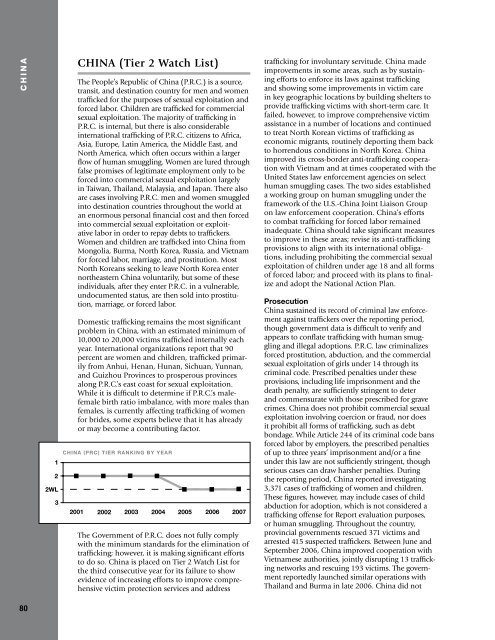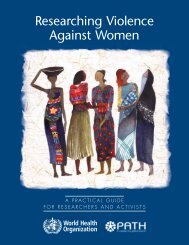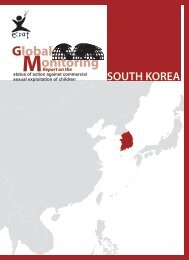2007 Trafficking in Persons Report - Center for Women Policy Studies
2007 Trafficking in Persons Report - Center for Women Policy Studies
2007 Trafficking in Persons Report - Center for Women Policy Studies
Create successful ePaper yourself
Turn your PDF publications into a flip-book with our unique Google optimized e-Paper software.
C H I N A<br />
80<br />
CHINA (Tier 2 Watch List)<br />
The People’s Republic of Ch<strong>in</strong>a (P.R.C.) is a source,<br />
transit, and dest<strong>in</strong>ation country <strong>for</strong> men and women<br />
trafficked <strong>for</strong> the purposes of sexual exploitation and<br />
<strong>for</strong>ced labor. Children are trafficked <strong>for</strong> commercial<br />
sexual exploitation. The majority of traffick<strong>in</strong>g <strong>in</strong><br />
P.R.C. is <strong>in</strong>ternal, but there is also considerable<br />
<strong>in</strong>ternational traffick<strong>in</strong>g of P.R.C. citizens to Africa,<br />
Asia, Europe, Lat<strong>in</strong> America, the Middle East, and<br />
North America, which often occurs with<strong>in</strong> a larger<br />
flow of human smuggl<strong>in</strong>g. <strong>Women</strong> are lured through<br />
false promises of legitimate employment only to be<br />
<strong>for</strong>ced <strong>in</strong>to commercial sexual exploitation largely<br />
<strong>in</strong> Taiwan, Thailand, Malaysia, and Japan. There also<br />
are cases <strong>in</strong>volv<strong>in</strong>g P.R.C. men and women smuggled<br />
<strong>in</strong>to dest<strong>in</strong>ation countries throughout the world at<br />
an enormous personal f<strong>in</strong>ancial cost and then <strong>for</strong>ced<br />
<strong>in</strong>to commercial sexual exploitation or exploitative<br />
labor <strong>in</strong> order to repay debts to traffickers.<br />
<strong>Women</strong> and children are trafficked <strong>in</strong>to Ch<strong>in</strong>a from<br />
Mongolia, Burma, North Korea, Russia, and Vietnam<br />
<strong>for</strong> <strong>for</strong>ced labor, marriage, and prostitution. Most<br />
North Koreans seek<strong>in</strong>g to leave North Korea enter<br />
northeastern Ch<strong>in</strong>a voluntarily, but some of these<br />
<strong>in</strong>dividuals, after they enter P.R.C. <strong>in</strong> a vulnerable,<br />
undocumented status, are then sold <strong>in</strong>to prostitution,<br />
marriage, or <strong>for</strong>ced labor.<br />
Domestic traffick<strong>in</strong>g rema<strong>in</strong>s the most significant<br />
problem <strong>in</strong> Ch<strong>in</strong>a, with an estimated m<strong>in</strong>imum of<br />
10,000 to 20,000 victims trafficked <strong>in</strong>ternally each<br />
year. International organizations report that 90<br />
percent are women and children, trafficked primarily<br />
from Anhui, Henan, Hunan, Sichuan, Yunnan,<br />
and Guizhou Prov<strong>in</strong>ces to prosperous prov<strong>in</strong>ces<br />
along P.R.C.’s east coast <strong>for</strong> sexual exploitation.<br />
While it is difficult to determ<strong>in</strong>e if P.R.C.’s malefemale<br />
birth ratio imbalance, with more males than<br />
females, is currently affect<strong>in</strong>g traffick<strong>in</strong>g of women<br />
<strong>for</strong> brides, some experts believe that it has already<br />
or may become a contribut<strong>in</strong>g factor.<br />
The Government of P.R.C. does not fully comply<br />
with the m<strong>in</strong>imum standards <strong>for</strong> the elim<strong>in</strong>ation of<br />
traffick<strong>in</strong>g; however, it is mak<strong>in</strong>g significant ef<strong>for</strong>ts<br />
to do so. Ch<strong>in</strong>a is placed on Tier 2 Watch List <strong>for</strong><br />
the third consecutive year <strong>for</strong> its failure to show<br />
evidence of <strong>in</strong>creas<strong>in</strong>g ef<strong>for</strong>ts to improve comprehensive<br />
victim protection services and address<br />
traffick<strong>in</strong>g <strong>for</strong> <strong>in</strong>voluntary servitude. Ch<strong>in</strong>a made<br />
improvements <strong>in</strong> some areas, such as by susta<strong>in</strong><strong>in</strong>g<br />
ef<strong>for</strong>ts to en<strong>for</strong>ce its laws aga<strong>in</strong>st traffick<strong>in</strong>g<br />
and show<strong>in</strong>g some improvements <strong>in</strong> victim care<br />
<strong>in</strong> key geographic locations by build<strong>in</strong>g shelters to<br />
provide traffick<strong>in</strong>g victims with short-term care. It<br />
failed, however, to improve comprehensive victim<br />
assistance <strong>in</strong> a number of locations and cont<strong>in</strong>ued<br />
to treat North Korean victims of traffick<strong>in</strong>g as<br />
economic migrants, rout<strong>in</strong>ely deport<strong>in</strong>g them back<br />
to horrendous conditions <strong>in</strong> North Korea. Ch<strong>in</strong>a<br />
improved its cross-border anti-traffick<strong>in</strong>g cooperation<br />
with Vietnam and at times cooperated with the<br />
United States law en<strong>for</strong>cement agencies on select<br />
human smuggl<strong>in</strong>g cases. The two sides established<br />
a work<strong>in</strong>g group on human smuggl<strong>in</strong>g under the<br />
framework of the U.S.-Ch<strong>in</strong>a Jo<strong>in</strong>t Liaison Group<br />
on law en<strong>for</strong>cement cooperation. Ch<strong>in</strong>a’s ef<strong>for</strong>ts<br />
to combat traffick<strong>in</strong>g <strong>for</strong> <strong>for</strong>ced labor rema<strong>in</strong>ed<br />
<strong>in</strong>adequate. Ch<strong>in</strong>a should take significant measures<br />
to improve <strong>in</strong> these areas; revise its anti-traffick<strong>in</strong>g<br />
provisions to align with its <strong>in</strong>ternational obligations,<br />
<strong>in</strong>clud<strong>in</strong>g prohibit<strong>in</strong>g the commercial sexual<br />
exploitation of children under age 18 and all <strong>for</strong>ms<br />
of <strong>for</strong>ced labor; and proceed with its plans to f<strong>in</strong>alize<br />
and adopt the National Action Plan.<br />
Prosecution<br />
Ch<strong>in</strong>a susta<strong>in</strong>ed its record of crim<strong>in</strong>al law en<strong>for</strong>cement<br />
aga<strong>in</strong>st traffickers over the report<strong>in</strong>g period,<br />
though government data is difficult to verify and<br />
appears to conflate traffick<strong>in</strong>g with human smuggl<strong>in</strong>g<br />
and illegal adoptions. P.R.C. law crim<strong>in</strong>alizes<br />
<strong>for</strong>ced prostitution, abduction, and the commercial<br />
sexual exploitation of girls under 14 through its<br />
crim<strong>in</strong>al code. Prescribed penalties under these<br />
provisions, <strong>in</strong>clud<strong>in</strong>g life imprisonment and the<br />
death penalty, are sufficiently str<strong>in</strong>gent to deter<br />
and commensurate with those prescribed <strong>for</strong> grave<br />
crimes. Ch<strong>in</strong>a does not prohibit commercial sexual<br />
exploitation <strong>in</strong>volv<strong>in</strong>g coercion or fraud, nor does<br />
it prohibit all <strong>for</strong>ms of traffick<strong>in</strong>g, such as debt<br />
bondage. While Article 244 of its crim<strong>in</strong>al code bans<br />
<strong>for</strong>ced labor by employers, the prescribed penalties<br />
of up to three years’ imprisonment and/or a f<strong>in</strong>e<br />
under this law are not sufficiently str<strong>in</strong>gent, though<br />
serious cases can draw harsher penalties. Dur<strong>in</strong>g<br />
the report<strong>in</strong>g period, Ch<strong>in</strong>a reported <strong>in</strong>vestigat<strong>in</strong>g<br />
3,371 cases of traffick<strong>in</strong>g of women and children.<br />
These figures, however, may <strong>in</strong>clude cases of child<br />
abduction <strong>for</strong> adoption, which is not considered a<br />
traffick<strong>in</strong>g offense <strong>for</strong> <strong>Report</strong> evaluation purposes,<br />
or human smuggl<strong>in</strong>g. Throughout the country,<br />
prov<strong>in</strong>cial governments rescued 371 victims and<br />
arrested 415 suspected traffickers. Between June and<br />
September 2006, Ch<strong>in</strong>a improved cooperation with<br />
Vietnamese authorities, jo<strong>in</strong>tly disrupt<strong>in</strong>g 13 traffick<strong>in</strong>g<br />
networks and rescu<strong>in</strong>g 193 victims. The government<br />
reportedly launched similar operations with<br />
Thailand and Burma <strong>in</strong> late 2006. Ch<strong>in</strong>a did not
















